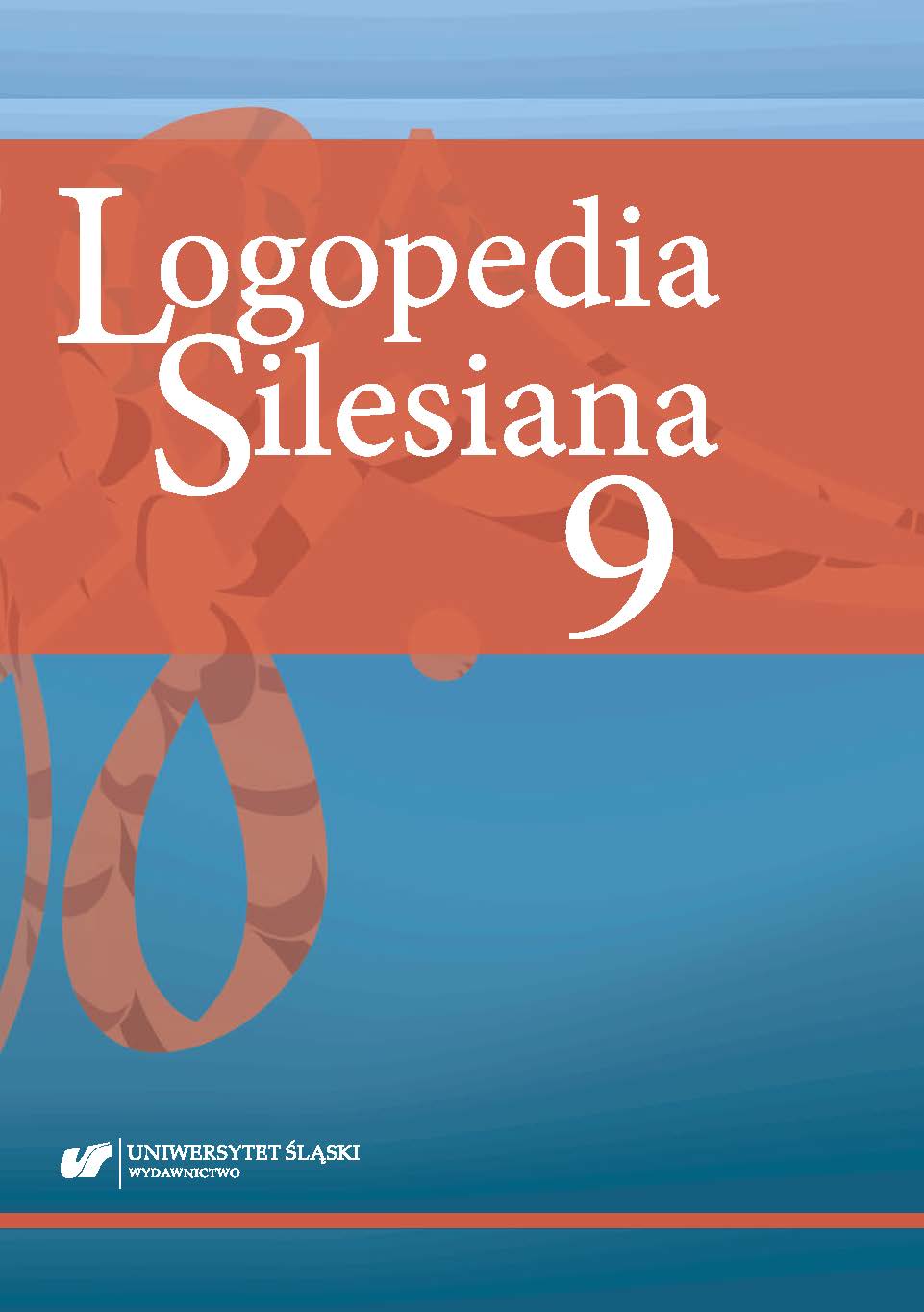Bokus, B. (1991). Tworzenie opowiadań przez dzieci. O linii i polu narracji. Kielce: Energeia.
Google Scholar
Błasiak-Tytuła, M. (2015). Narracja a rozumienie u dzieci dwujęzycznych. W: M. Błasiak-Tytuła, M. Korendo, A. Siudak (red.), Nowa Logopedia. Rozumienie – diagnoza i terapia (t. 6, s. 135−145). Kraków: Wydawnictwo Collegium Columbinum.
Google Scholar
Cieszyńska, J. (2013). Metoda Krakowska wobec zaburzeń rozwoju dzieci. Z perspektywy fenomenologii, neurobiologii i językoznawstwa. Kraków: Wydawnictwo Centrum Metody Krakowskiej.
Google Scholar
Dereń, E. (2005). Opis a opowiadanie: typowe słownictwo szkolnych form wypowiedzi. Nauczyciel i Szkoła, 3–4(28–29), 145−159.
Google Scholar
Dryżałowska, G. (2007). Rozwój językowy dziecka z uszkodzonym słuchem a integracja edukacyjna. Model kształcenia integracyjnego. Warszawa: Wydawnictwa Uniwersytetu Warszawskiego.
Google Scholar
Dzięcioł-Chlibiuk, E. (2019). Realizacja struktury opisu na podstawie wypowiedzi ustnych i pisanych osób z uszkodzonym słuchem. Logopedia Silesiana, 8, 209−232.
Google Scholar
Faściszewska, M. (2020). Jąkanie. Wypowiedzi dialogowe i narracyjne osób jąkających się. Gdańsk: Wydawnictwo Uniwersytetu Gdańskiego.
Google Scholar
Grabias, S., (2012). Teoria zaburzeń mowy. Perspektywy badań, typologie zaburzeń, procedury postępowania logopedycznego. W: S. Grabias, Z.M. Kurkowski (red.), Logopedia. Teoria zaburzeń mowy (s. 15−71). Lublin: Wydawnictwo Uniwersytetu Marii Curie-Skłodowskiej.
Google Scholar
Grabias, S. (2015). Postępowanie logopedyczne. Standardy terapii. W: S. Grabias, J. Panasiuk, T. Woźniak (red.), Logopedia. Standardy postępowania logopedycznego (s. 13–35). Lublin: Wydawnictwo Uniwersytetu Marii Curie-Skłodowskiej.
Google Scholar
Grabias, S. (2019). Język w zachowaniach społecznych. Podstawy socjolingwistyki i logopedii. Lublin: Wydawnictwo Uniwersytetu Marii Curie-Skłodowskiej.
Google Scholar
Grabias, S., Kurkowski, Z.M., Woźniak, T. (2002). Logopedyczny test przesiewowy dla dzieci w wieku szkolnym. Lublin: Wydawnictwo Uniwersytetu Marii Curie-Skłodowskiej, Zakład Logopedii i Językoznawstwa Stosowanego, Polskie Towarzystwo Logopedyczne.
Google Scholar
Jastrzębowska, G. (2003). Wprowadzenie. Problemy terminologiczne i definicyjne. W: T. Gałkowski, G. Jastrzębowska (red.), Logopedia – pytania i odpowiedzi. Podręcznik akademicki (t. 2, s. 9−36). Opole: Wydawnictwo Uniwersytetu Opolskiego.
Google Scholar
Jóźwicki, T. (1984). Opowiadanie jako forma wypowiedzi w klasach początkowych. Warszawa: Wydawnictwa Szkolne i Pedagogiczne.
Google Scholar
Kielar-Turska, M. (1989). Mowa dziecka. Słowo i tekst. Kraków: Wydawnictwo Uniwersytetu Jagiellońskiego.
Google Scholar
Kielar-Turska, M. (2018). Dziecięca kompetencja narracyjna: rozumienie istoty narracji i umiejętność opowiadania. Studia Pragmalingwistyczne, 10, 211−224.
Google Scholar
Kołodziejczyk, R. (2015). Trudności gramatyczne u dzieci i młodzieży z uszkodzeniami słuchu. W: E. Muzyka-Furtak (red.), Surdologopedia. Teoria i praktyka (s. 156–175). Gdańsk: Harmonia Universalis.
Google Scholar
Krakowiak, K. (2012). Dar języka. Podręcznik metodyki wychowania językowego dzieci i młodzieży z uszkodzeniami narządu słuchu. Lublin: Wydawnictwo Katolickiego Uniwersytetu Lubelskiego.
Google Scholar
Kulawik, A. (1997). Poetyka. Wstęp do teorii dzieła literackiego. Kraków: Antykwa.
Google Scholar
Kulpa, J., Więckowski, R. (1997). Formy ćwiczeń w mówieniu i pisaniu. W: M. Węglińska (red.), Opowiadanie jako forma wypowiedzi w klasach początkowych (s. 62−64). Kraków: Impuls.
Google Scholar
Kyrc, B. (2018). Rozwijanie kompetencji narracyjnej dziecka dwujęzycznego w Polsce a jego sukces edukacyjny. Porównawcze studium przypadku. Języki Obce w Szkole, 4, 85−92.
Google Scholar
Malendowicz, J. (1997). Kształtowanie pisemnych wypowiedzi uczniów w klasach II–IV. W: M. Węglińska (red.), Opowiadanie jako forma wypowiedzi w klasach początkowych (s. 59−62). Kraków: Impuls.
Google Scholar
Nagajowa, M. (1977). Ćwiczenia w mówieniu i pisaniu w klasach V–VIII szkoły podstawowej. Warszawa: Wydawnictwa Szkolne i Pedagogiczne.
Google Scholar
Nagajowa, M. (1990). ABC metodyki języka polskiego dla początkujących nauczycieli. Warszawa: Wydawnictwa Szkolne i Pedagogiczne.
Google Scholar
Orłowska-Popek, Z., Błasiak-Tytuła, M. (2017). Dziennik wydarzeń jako technika kształtowania kompetencji komunikacyjnej w sytuacji dwujęzyczności. Conversatoria Linguistica, 11, 157−170.
Google Scholar
Panasiuk, J. (2013). Afazja a interakcja. TEKST – metaTEKST – konTEKST. Lublin: Wydawnictwo Uniwersytetu Marii Curie-Skłodowskiej.
Google Scholar
Przybyla, O. (2018). Kompetencja narracyjna uczniów z zaburzeniami rozwoju koordynacji. Logopedia, 47–2, 303−316.
Google Scholar
Rakowska, A. (1992). Rozwój systemu gramatycznego u dzieci głuchych. Kraków: Wydawnictwo Naukowe Wyższej Szkoły Pedagogicznej.
Google Scholar
Skudrzyk, A., Warchala, J. (2010). Kultura piśmienności młodzieży szkolnej − badania w perspektywie analfabetyzmu funkcjonalnego. Studia Pragmalingwistyczne, 2, 55−65.
Google Scholar
Soroko, E., Wojciechowska, J. (2015). Kompetencja narracyjna jako obszar nauczania i oceny edukacji. Studia Edukacyjne, 37, 211−236.
Google Scholar
Tarkowski, Z. (1987). Jąkanie. Zagadnienia etiologii, diagnozy, terapii i prognozy. Warszawa: Wydawnictwo ZSL.
Google Scholar
Tarkowski, Z. (2017). Jąkanie. W: Z. Tarkowski (red.), Patologia mowy (s. 123−148). Gdańsk: Harmonia Universalis.
Google Scholar
Węglińska, M. (1997). Opowiadanie jako forma wypowiedzi w klasach początkowych – istota, struktura. W: M. Węglińska (red.), Opowiadanie jako forma wypowiedzi w klasach początkowych (s. 9−18). Kraków: Impuls.
Google Scholar
Witosz, B. (1997). Opis w prozie narracyjnej na tle innych odmian deskrypcji. Zagadnienia struktury tekstu. Katowice: Wydawnictwo Uniwersytetu Śląskiego.
Google Scholar
Wolańska, E. (2010). Wykładniki spójności tekstów renarracji tworzonych przez młodzież szkolną w wieku 12–13 lat. Studia Pragmalingwistyczne, 2, 104−114.
Google Scholar
Woźniak, T. (2005). Narracja w schiozofrenii. Lublin: Wydawnictwo Uniwersytetu Marii Curie-Skłodowskiej.
Google Scholar
Wyrwas, K. (2014). Opowiadania potoczne w świetle genologii lingwistycznej. Katowice: Wydawnictwo Uniwersytetu Śląskiego.
Google Scholar


 https://doi.org/10.31261/LOGOPEDIASILESIANA.2020.09.08
https://doi.org/10.31261/LOGOPEDIASILESIANA.2020.09.08

 10.31261/LOGOPEDIASILESIANA
10.31261/LOGOPEDIASILESIANA